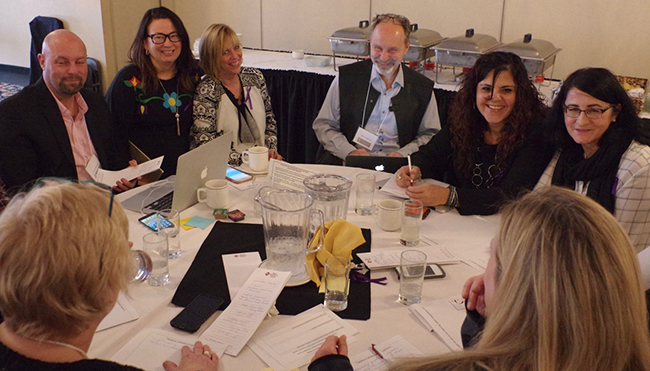New curriculum to include Indigenous education

By Rick Garrick
THUNDER BAY – Staff at the Superior North Catholic District School Board are looking forward to implementing the Ministry of Education’s new curriculum in their nine schools.
“It takes us back to the ideas and the understanding of what our ancestors had, like our government system, our teachings, and just how that was lost,” says Donna Borg, Native language and culture teacher at St. Edward Catholic School in Nipigon and Red Rock Indian Band citizen. “That historical piece is being brought back in and it is just a real eye opener. It’s a start — we don’t really know if this is going to stop racism, we don’t know if it is going to bring healing. But I’m hoping it will and I’m thinking that this is a start.”
The Ministry of Education introduced the new curriculum to northwestern Ontario’s school boards during a Dec. 6-7 gathering at the Best Western Plus Nor’Wester Hotel and Conference Centre in Thunder Bay.
“Myself being Aboriginal, it is really strange because a lot of the teachings that are being taught to the non-Aboriginal educators that are here, it’s like I know what they are talking about and I just feel like kind of special about it,” Borg says. “This is part of my history and it’s something that I’d assumed that (other) people knew.”
The Ministry of Education’s curriculum enhancements were driven through the Truth and Reconciliation Commission’s Calls to Action, specifically Calls to Action 62 and 63.
“In terms of responding directly to those Calls to Action within Ontario’s curriculum, we see that history beginning around the Grade 4 timeline, which talks about our old stories or how things were a long time ago in this place,” says Nick Bertrand, from the Ministry of Education’s Indigenous education office. “So we start there and we build up to the Grade 5 period where we are talking about contact between Indigenous and Europeans at the time and continuing forward along that historical timeline right up until 2017 today. So it’s really unpacking the whole story of this place and really exploring the truth that may not have been part of the learning in the past.”
Alexa McKinnon, director of education for Superior North Catholic District School Board, says the board’s Indigenous student population ranges from about 30 to 100 per cent, depending on the school. The board has schools in Nipigon, Schreiber, Terrace Bay, Marathon, Red Rock, Geraldton, Longlac, Nakina and Manitouwadge.
“Our main focus is Indigenous education and building capacity and changing our environments in our school, working in partnership with our communities and making sure that we are all connecting,” McKinnon says. “That is the goal and we are very intentional about it. I am not Indigenous but I am working really hard as a director to build capacity and make it a number one priority in our board.”
McKinnon says the board has already introduced Native as a second language for students from Kindergarten to Grade 8. They have also developed an Experience Superior North program for boards from southern Ontario to introduce Grade 10-12 students to their Indigenous ways.
“We have five boards coming up in May,” McKinnon says. “We take them on a five-day journey of learning. Our Grades 5, 6, 7 and 8 students are so proud to share their Indigenous ways. It’s a win-win — it’s connecting provincially and who knows where it is going to go next.”


